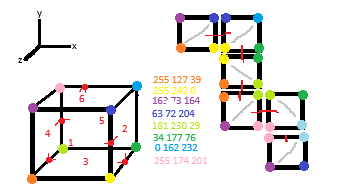Angus's Website
Party
View party siteHere are my public messages
Meet my new cat! it lives below.
19th April 2025 21:18Missing you loads Tara!
10th April 2025 17:35Hi Tara, Dinner will be ready at 23:20 Xx
28th March 2025 22:32Hi Katherine, check out this site! I'm not starting a business - just got the domain for fun. Will probably put some blog style content on here.
26th March 2025 09:21Hi Tara, have a lovely day too XXX
26th March 2025 09:19My cats live here.
My horse lives here.
My particles live here.
Here's my WebGL canvas
A short write-up this time: I've copy-pasted my cube!
To do this, I:
- Created an array of vectors of corners of a unit cube:
const corners = new Float32Array([0,0,1,...]);. - Passed that array to the GPU at the start of the program:
gl.bufferData(gl.ARRAY_BUFFER, corners, gl.STATIC_DRAW);. I also pass a similar array of vertex colours at this point. - For each frame, I assemble a transformation matrix representing the position of the cube, and pass that to the GPU with
gl.uniformMatrix4fv(cubeTransformationLocation, false, cubeTransformationMatrix);. This looks a bit different from the above step: It's a 4x4 matrix, passed as a uniform (a variable that's the same for all vertices in the cube), to the vertex shader of the cube (that computes the cube vertices' positions). - Finally, I draw the cube with
gl.drawArrays(gl.LINES, 0, 6*2*6);.
To duplicate the cube, I only needed to duplicate steps 3 and 4! (I did some development work on the matrix transformations too - it's now quite painless to specify translations and rotations).
10th April 2025 17:23
I've created a cube! I sketched the cube out in Paint (pictured), ascribed coordinates to each corner, flattened it into a mesh, and then specified each line to the GPU as a pair of coordinates. The colours were essential for debugging vertices in the wrong place and misorientation of the x/y/z axes. The flattened mesh was essential for defining triangles, which need to be specified with vertexes in an anticlockwise chirality for the faces to point outwards.
I needed to transform the created cube: I wanted it to spin, and it was upside-down.
A transformation is assembled from elementary transformations with the 'and then' operator. Mathematically, transformations are represented by a matrix, with the 'and then' operator as a matrix multiplication.
Composing a transformation is only required once per frame, so should be coded in JavaScript, not for the GPU. The GPU runs calculation functions (or shaders) that are called for each vertex in the scene so should be kept simple for performance reasons. Because the composition of the global transformation matrix doesn't need repeating for all vertices, and because there's a performance penalty for shuttling data between the CPU and the GPU, it should run on the CPU, in the JavaScript code.
The GPU's role is then to set each vertex's colour, and to perform a single matrix multiplication to transform its position from x-y-z space into a coordinate system with the observer at the origin, and the line of sight along the negative Y axis (or something).
Computing these transformation matrices in JavaScript required me to code up a matrix multiplication function. Unintuitively, in graphics programming, matrices are column major, which complicates the process. There's a long comment in the JavaScript code with more detailed information on this.
30th March 2025 20:56I've been preparing to start using OpenGL this evening! This will be my first time coding for a GPU. I intend to feed in position and orientation coordinates of an observer, and transform my trusty red square. I've just put in some JS to use the WASD keys to capture observer position, now to create the transformation matrices and use them.
At long last I have movement of my square! [Two rotating red squares—the front and back faces of a cube— are visble.] It looks like 2 spinning squares rather than a cube, as I haven't meshed the cube properly; I've specified 8 vertices, and the shader has only drawn triangles between some of them.
As promised, the GPU has a wealth of linear algebra methods. Unfortunately, the linear algera used to find the observer's transformation matrix, that occurs once per frame, needs to run on the CPU, and therefore needs to be coded up in JS (eugh).
28th March 2025 01:55